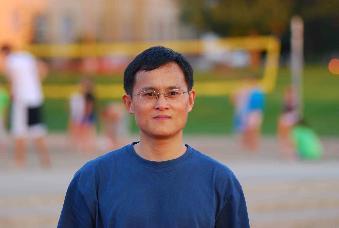
Gao Xianlong
professor Supervisor of Doctorate Candidates Supervisor of Master's Candidates
Honors and Titles : Program for New Century Excellent Talents in University
Gender : Male
Alma Mater : University of Science and Technology of China
Education Level : Graduate student graduate
Degree : Doctorate
Status : 在岗
School/Department : College of Mathematics, Physics and Information Engineering
Date of Employment : 2007-03-29
Discipline : physics
Business Address : Science Building 29#-429
Contact Information : 0579-82298507, 667810(short)
Email :
Hits :
First Author : 宋世英
Affiliation of Author(s): 数理与信息工程学院
Date of Publication : 2013-01-01
Document Type : 期刊
Journal : 浙江师范大学学报(自然科学版)
Issue : 第1期
Page Number : 68-73
ISSN : 1001-5051
Translation or Not : no
Key Words : 无序;一维;Dirac电子;电子密度分布
Abstract : 通过有限差分的方法,数值计算了一个相对论性质的Dirac电子在磁场和无序同时存在时的能谱结构,并讨论了不同磁场强度和无序强度时电子密度分布的变化情况.结果发现:随着无序强度的增大,无序势削弱了磁场对电子的捕获,使局域化现象减弱,使得无质量Dirac电子出现了有别于Anderson局域化的现象.
Born at Anhui Province, Feixi, Ph.D., Professor,
In 1998, Anhui University Department of Applied Physics, Theoretical Physics, Bachelor, Master,
In 2001, University of Science and Technology of China, Department of Astronomy and Applied Physics, Condensed matter physics, Ph.D
Research Interests:
1. Quantum properties of low-dimensional Fermi gas: Studying the exotic quantum phases due to the fermion species, pairing, the external potential, and the interaction;
2. Density functional theory of low-dimensioanl system;
Homogeneous low-dimensional systems are strictly solvable in many cases (eg using the Bethe-Ansatz technique, Bosonization, etc.), and for the inhomogeneous systems they are more complicated and can often be solved by using density functional theory. We study the applications of the density functional theory in the model system. Related examples can be found in the application of density functional theory in the inhomogeneous Hubbard model, non-uniform Lieb-Wu model, Anderson model and Bose-Fermi mixed system. The same idea can be used to deal with disordered problems, finite temperature effects, various dynamical problems;
3. Numerical study of low-dimensional strong correlation system: By means of strict diagonalization and numerical renormalization group, we discuss the ground state, especially the correlation function of low-dimensional systems;
4. Excitation properties of low-dimensional strongly correlation systems: studying low energy excitation such as spin-charge separation phenomenon, spin-drag effect due to the relative motion of different types of fermions, and the use of variational methods and local density approximation to solve the finite temperature, low energy excitation mode.
For students:
I am currently tutoring several graduate students for scientific research. At the same time, I am organizing and supervising a number of junior undergraduates for research and develop their research interests.
See details at http://physics.zjnu.edu.cn/2016/0303/c2480a26226/page.htm
Research team http://course.zjnu.cn/qm/gao/